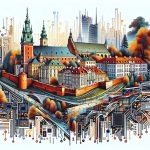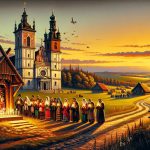
Polish literature has a deep history that shows us how the culture and big moments in Poland’s past have shaped its stories and impacted literature across Europe.
Starting with medieval texts that help us understand Poland’s early days, through the creativity of the Renaissance and thoughtful works of the Enlightenment, to the powerful stories from wartime and the lively tales following the fall of communism, every era shows a different side of the Polish spirit and way of thinking.
Diving into these stories not only gives us a glimpse into Poland’s soul but also makes us think about common human experiences like overcoming challenges and being creative. What’s really interesting is seeing how these different times connect, making us look at Polish literature and the wider world in new and interesting ways.
The Medieval Beginnings
The start of Polish literature dates back to the medieval times, specifically from the 11th to the 15th centuries. This period is crucial because it marks the beginning of a tradition that would grow incredibly rich over time. Initially, Polish literary works were mostly written in Latin and focused on religious themes. These early texts included stories of saints (hagiographies), historical accounts (chronicles), and religious poetry meant for liturgical purposes.
One standout piece from this era is the ‘Bogurodzica,’ notable for being the oldest known Polish anthem. It’s an excellent example of how even in its early days, Polish literature was already carving out its unique identity. Latin played a vital role too. As the dominant language for scholarly and religious writing across Europe, its use in Poland helped introduce European intellectual trends to the country. This exchange was crucial for shaping Poland’s early literary culture, making it a part of a broader European conversation.
These beginnings are not just historical footnotes. They represent the roots from which Polish literature would grow, influenced by and contributing to European culture. Understanding this period helps us appreciate the depth and breadth of Polish literary traditions and how they continue to evolve today.
Renaissance and Reformation
During the Renaissance and Reformation periods, Polish literature underwent significant changes. This was a time when Europe as a whole was shifting its views on culture and intellect. Polish authors started to dive into the works of ancient Greek and Roman thinkers, which was a big deal because it showed their growing interest in Humanism. This movement emphasized human values and the study of classical antiquities.
Then came the Reformation, which really shook things up by introducing religious texts in everyday language. This move made these texts easier for more people to read and understand, breaking down the barriers that Latin texts had set up during the Medieval period. It was a game-changer in making knowledge and literature more democratic.
Two Polish writers really stood out during this time: Mikolaj Rej and Jan Kochanowski. They managed to blend the ideas of Humanism with the Polish language in their works. This fusion not only made their writing uniquely Polish but also something that could resonate with people everywhere. It was a clear move away from the past and marked the beginning of a new chapter in Polish literary history.
What’s interesting about this era is how it connects to broader European trends while also highlighting the unique Polish contribution. The move towards using the vernacular language, for instance, wasn’t just happening in Poland. But the way Polish writers did it, especially with the flair of Humanism, gave their works a distinct flavor.
Enlightenment and Partition
The Enlightenment era in Poland was a time of great intellectual and cultural growth, followed by the challenging period of partition. This era was marked by a strong emphasis on reason, freedom, and critiquing social norms. Polish literature thrived, producing works that reflected Enlightenment ideals and integrated them with the country’s cultural identity.
Yet, when Poland was divided among Russia, Prussia, and Austria, it faced political and cultural oppression. This difficult time led Polish writers to focus more on themes of national survival, identity, and resistance against the partitioning powers. They wrote to critique these powers, preserve Polish culture, and foster hope for freedom and self-rule.
For example, during the Enlightenment, Polish authors like Stanisław Konarski and Ignacy Krasicki were pivotal in promoting educational reform and satirizing societal flaws, respectively. Their works are prime examples of the era’s intellectual vibrancy. However, after the partitions, the tone of Polish literature shifted significantly. Adam Mickiewicz’s ‘Pan Tadeusz’ is a classic example from this period, intertwining personal and national themes to inspire hope and unity among Poles.
Understanding these shifts in Polish literature offers insight into how national identity and cultural expression can be profoundly affected by political changes. It also shows the resilience of culture and the power of literature to inspire and mobilize a nation against oppression. Whether you’re interested in the philosophical debates of the Enlightenment or the passionate calls for sovereignty in later works, Polish literature from these periods provides a rich tapestry of ideas and emotions that resonate with the struggles and aspirations of a nation.
War and Occupation
Throughout history, war and occupation have deeply shaped Polish literature. These times have not only been a backdrop for stories about bravery and the horrors of war but have also explored the deep psychological effects of living under an oppressive regime. Polish authors used their writings to keep their national identity alive, cleverly employing allegory and symbolism to dodge censorship while touching on the shared experiences of their people. During the war, a significant body of resistance literature emerged. Authors used their work as a tool to document the struggles and to fight against the erasure of Polish culture and history. This literary period highlighted the unbreakable spirit of Poland, showing how resilience can shine through in the darkest of times.
For example, during World War II, Polish literature thrived under unimaginable conditions. Writers like Zofia Nałkowska in her work ‘Medallions’ offered raw accounts of the war’s impact on civilians, using straightforward narratives to capture the gravity of their experiences. Meanwhile, Czesław Miłosz’s ‘The Captive Mind’ delved into the intellectual and moral dilemmas faced by artists and thinkers under a totalitarian regime, using clear and compelling arguments to discuss the complexities of freedom and conformity. These works, and many others, stood as testaments to the enduring power of the human spirit and the role of literature in challenging oppression.
In this way, Polish literature during times of conflict and occupation serves as a vivid reminder of the power of storytelling. It not only records historical events but also offers insight into the resilience of the human spirit. By turning to literature, we gain a deeper understanding of the impact of war and occupation on a nation’s psyche and the unyielding desire for freedom and self-expression. This period of Polish literary history offers rich lessons on the importance of preserving cultural identity and the transformative power of the written word in the face of adversity.
Post-Communism Era
After the fall of communism, Polish literature embarked on a journey of transformation. This new era allowed writers to freely explore themes of freedom, identity, and the intricacies of a society emerging from the shadows of a repressive regime. The literature from this time is rich and varied, showcasing a nation in the midst of redefining itself.
Authors started to focus on the psychological and social effects of Poland’s dramatic shift. They examined how the legacy of communism shaped modern life, often presenting stories that balanced between looking back with nostalgia and forward with critical eyes. This balance highlights the struggle to maintain cultural memory while striving to build a new, distinct identity.
One of the most exciting developments of this period is the experimentation with narrative styles. Polish writers began experimenting with new forms to better capture the complex experiences of their country’s transition. For example, Olga Tokarczuk, a Nobel Prize-winning author, is known for her innovative narrative techniques that challenge traditional storytelling.
The literature of post-communist Poland is a testament to the country’s resilience and creativity. It not only reflects the nation’s journey through a significant historical turning point but also contributes to the broader understanding of how societies navigate periods of profound change. Through their works, Polish authors invite readers to consider the depth of human experience in times of transition, offering insights that resonate well beyond their national context.
Conclusion
Polish literature has come a long way, changing a lot from its early days in the medieval period all the way to the modern times after communism. This change shows the big historical events that have happened, like the Renaissance, the times when Poland was divided, and the tough periods of war and occupation.
Polish literature isn’t just a reflection of Poland’s complicated history, it also shows how strong and flexible its culture is. Throughout its different stages, Polish literature has made a big impact on the world of books.






Comments are closed.